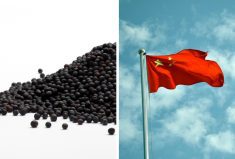A study from the federal external relations department Global Affairs Canada is drawing sharp criticism for ignoring the costs to agriculture.
The study says Canada would gain $4.3 billion in trade benefits from the proposed Trans-Pacific Partnership, but critics say it doesn’t properly account for the impact on farmers.
TPP gains would be offset by the cost of compensating farmers for their losses, says Maude Barlow, national chairperson of the Council of Canadians.
“The department’s study predicts additional economic growth of just 0.127 per cent over two decades,” Barlow said. “Coincidentally, that growth – estimated to be worth $4.3 billion – is the exact same amount that was promised to farmers to compensate them for their losses.”
Read Also

Finally getting paid for sustainable farming?
Alberta project says they might have a line on a workable ecosystem credit model to reward farmers for sustainability, and Manitoba might be next
She noted that means a zero net economic gain and ignores the way the deal will then translate into higher costs for ordinary Canadians.
“Canadians are still on the hook for more expensive prescription drugs and costly corporate lawsuits,” Barlow said. She repeated calls for an independent study of the TPP benefits by the Parliamentary Budget Officer.
Ron Bonnett, president of the Canadian Federation of Agriculture, said in an interview that trying to forecast the long-term benefits of a trade deal “is like a gamblers’ game. You’re trying to predict very far out.”
At the same time, agri-food and other sectors of the Canadian economy can’t be left out of trade deals that their major competitors have access to, he points out.
“We have to be kept in a competitive situation,” he said.
Although the TPP agreement isn’t up for ratification until 2017, the government is continually lobbied to commit to ratification or rejection of it. Thus far, the government has said it will continue to participate in talks about it.
The fate of the TPP pact most likely depends on the outcome of the U.S. election. Republican candidate Donald Trump is opposed to it while Democratic nominee Hillary Clinton has serious reservations about it.
The Canadian study, prepared by the Office of the Chief Economist at Global Affairs Canada, says the deal would deliver a $4.3-billion boost to Canada’s GDP by 2040, due primarily to the preferential access it would receive to markets in the Asia-Pacific rim. If the government doesn’t ratify it and the other 11 countries do, the country would face estimated GDP losses of $5.3 billion during the next 25 years because of missed opportunities to enhance trade and an erosion of Canada’s preferential market position within NAFTA.
Barlow said the GAC study relies on the discredited Global Trade Analysis Project from Purdue University which makes economic assumptions that don’t match reality. The methodology “is heavily biased toward demonstrating the positive effects, while sidelining potential negative effects.” The study uses a too positive projection of economic growth and downplays losses in the auto industry.
“The study does not consider unemployment rates, one of the most important variables for Canadians’ well-being,” she said. “Growth and employment are not necessarily synonymous, and trade deals often exert downward pressure on wages.”
The study also ignored the fate of the high-tech sector, increased costs of prescription drugs for Canadian families and the public health-care system due to strengthened pharmaceutical patents. It also excludes the cost of investor-state dispute settlement cases, estimated at $4 million per case to defend.















